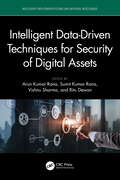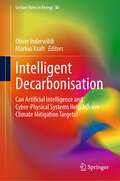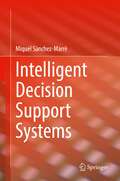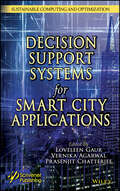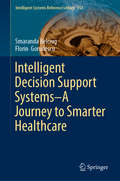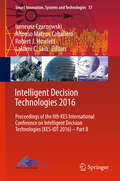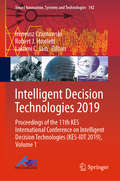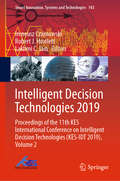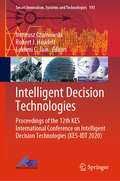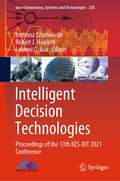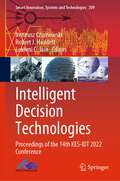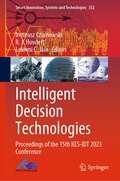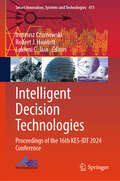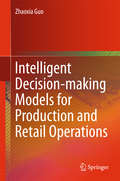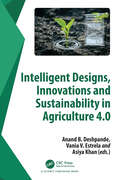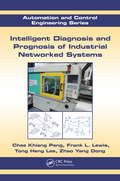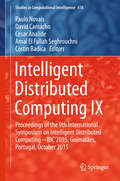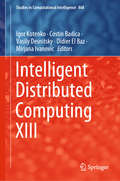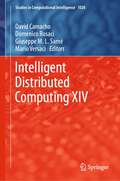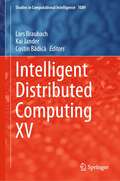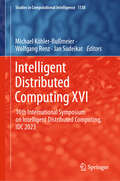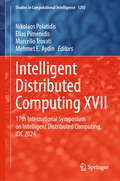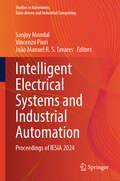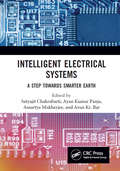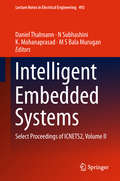- Table View
- List View
Intelligent Data-Driven Techniques for Security of Digital Assets (Intelligent Data-Driven Systems and Artificial Intelligence)
by Arun Kumar Rana Vishnu Sharma Sumit Kumar Rana Ritu DewanThe book covers the role of emerging technologies such as blockchain technology, machine learning, IoT, cryptography, etc., in digital asset management. It further discusses digital asset management applications in different domains such as healthcare, travel industry, image processing, and our daily life activities to maintain privacy and confidentiality.This book:• Discusses techniques for securing and protecting digital assets in collaborative environments, where multiple organizations need access to the same resources.• Explores how artificial intelligence can be used to automate the management of digital assets, and how it can be used to improve security and privacy.• Explains the role of emerging technology such as blockchain technology for transforming conventional business models.• Highlights the importance of machine learning techniques in maintaining the privacy and security of data.• Covers encryption and decryption techniques, their advantages and role in improving the privacy of data.The text is primarily written for senior undergraduates, graduate students, and academic researchers in diverse fields including electrical engineering, electronics and communications engineering, computer science and engineering, information technology, and business management.
Intelligent Decarbonisation: Can Artificial Intelligence and Cyber-Physical Systems Help Achieve Climate Mitigation Targets? (Lecture Notes in Energy #86)
by Oliver Inderwildi Markus KraftThe book explains the need to decarbonise energy supplies, urban systems and industrial processes to reduce global greenhouse gases and meet the ambitious emissions reduction goals set out in the Paris Agreement 2016. It discusses how the introduction of AI to cyber-physical systems (CPS) can do this, using illustrations throughout to highlight the potential impacts.Intelligent Decarbonisation comprehensively assesses the current and future impact of digital technologies and artificial intelligence (AI) on the decarbonisation of key economic sectors.The book is divided into four parts – Technology, Impact, Implications and Incubation – moving clearly from the theoretical and technical to the real-world effects and areas for future development. It also presents insights into the economic and environmental transformation fostered by digital technologies.Intelligent Decarbonisation brings together work from private and public sector professionals, academics and think tank experts, and provides truly comprehensive insights into the topic. It is an interesting and informative text for policymakers, researchers and industry professionals alike.
Intelligent Decision Support Systems
by Miquel Sànchez-MarrèThis book presents the potential use and implementation of intelligent techniques in decision making processes involved in organizations and companies. It provides a thorough analysis of decisions, reviewing the classical decision theory, and describing usual methods for modeling the decision process. It describes the chronological evolution of Decision Support Systems (DSS) from early Management Information Systems until the appearance of Intelligent Decision Support Systems (IDSS). It explains the most commonly used intelligent techniques, both data-driven and model-driven, and illustrates the use of knowledge models in Decision Support through case studies. The author pays special attention to the whole Data Science process, which provides intelligent data-driven models in IDSS. The book describes main uncertainty models used in Artificial Intelligence to model inexactness; covers recommender systems; and reviews available development tools for inducing data-driven models, for using model-driven methods and for aiding the development of Intelligent Decision Support Systems
Intelligent Decision Support Systems for Smart City Applications (Concise Introductions to AI and Data Science)
by Loveleen Gaur Prasenjit Chatterjee Vernika AgarwalINTELLIGENT DECISION SUPPORT SYSTEMS FOR SMART CITY APPLICATIONS This book provides smart city frameworks to address new difficulties by adding new features and allowing the city environment to react to collected data and information to increase the efficiency and sustainability of services for inhabitants. Making a smart city is an emerging strategy to mitigate the problems generated by urban population growth and rapid urbanization. This book aims to provide a better understanding of the concept of smart cities and the application of an intelligent decision support system. Based on the analysis of existing information there are eight critical factors of smart city initiatives: management and organization, technology, governance, policy context, people and communities, economy, built infrastructure, and natural environment. This book will focus on the application of the decision support system in managing these eight crucial aspects of smart cities. The intent in writing this book was also to provide a source that covers the stage-by-stage integration of the four key areas involving planning, physical infrastructure, ICT infrastructure, and deploying the smart solutions necessary for city transformation. With this as the motivation, “Decision Support Systems for Smart City Applications” provides the application of an intelligent decision support system for effectively and efficiently managing the transformation process, which can aid various supply chain stakeholders, academic researchers, and related professionals in building smart cities. Various chapters of this book are expected to support practicing managers during the implementation of smart solutions for city transformation. Audience This book is aimed at both academics and practitioners alike in the fields of intelligent computing, decision support systems, the manufacturing industry, supply chain managers, stakeholders, policymakers, and other technical and administrative personnel.
Intelligent Decision Support Systems—A Journey to Smarter Healthcare (Intelligent Systems Reference Library #157)
by Smaranda Belciug Florin GorunescuThe goal of this book is to provide, in a friendly and refreshing manner, both theoretical concepts and practical techniques for the important and exciting field of Artificial Intelligence that can be directly applied to real-world healthcare problems. Healthcare – the final frontier. Lately, it seems like Pandora opened the box and evil was released into the world. Fortunately, there was one thing left in the box: hope. In recent decades, hope has been increasingly represented by Intelligent Decision Support Systems. Their continuing mission: to explore strange new diseases, to seek out new treatments and drugs, and to intelligently manage healthcare resources and patients. Hence, this book is designed for all those who wish to learn how to explore, analyze and find new solutions for the most challenging domain of all time: healthcare.
Intelligent Decision Technologies 2016: Proceedings of the 8th KES International Conference on Intelligent Decision Technologies (KES-IDT 2016) – Part II (Smart Innovation, Systems and Technologies #57)
by Lakhmi C. Jain Robert J. Howlett Ireneusz Czarnowski Alfonso Mateos CaballeroThe KES-IDT-2016 proceedings give an excellent insight into recent research, both theoretical and applied, in the field of intelligent decision making. The range of topics explored is wide, and covers methods of grouping, classification, prediction, decision support, modelling and many more in such areas as finance, linguistics, medicine, management and transportation. This proceedings contain several sections devoted to specific topics, such as: · Specialized Decision Techniques for Data Mining, Transportation and Project Management · Pattern Recognition for Decision Making Systems · New Advances of Soft Computing in Industrial and Management Engineering · Recent Advances in Fuzzy Systems · Intelligent Data Analysis and Applications · Reasoning-based Intelligent Systems · Intelligent Methods for Eye Movement Data Processing and Analysis · Intelligent Decision Technologies for Water Resources Management · Intelligent Decision Making for Uncertain Unstructured Big Data · Decision Making Theory for Economics · Interdisciplinary Approaches in Business Intelligence Research and Practice · Pattern Recognition in Audio and Speech Processing The KES-IDT conference is a well-established international annual conference, interdisciplinary in nature. These two volumes of proceedings form an excellent account of the latest results and outcomes of recent research in this leading-edge area.
Intelligent Decision Technologies 2019: Proceedings of the 11th KES International Conference on Intelligent Decision Technologies (KES-IDT 2019), Volume 1 (Smart Innovation, Systems and Technologies #142)
by Lakhmi C. Jain Robert J. Howlett Ireneusz CzarnowskiThe book presents a collection of peer-reviewed articles from the 11th KES International Conference on Intelligent Decision Technologies (KES-IDT-19), held Malta on 17–19 June 2019. The conference provided opportunities for the presentation of new research results and discussion about them. It was also an opportunity to generation of new ideas in the field of intelligent decision making. The range of topics explored is wide, and covers methods of classification, prediction, data analysis, decision support, modelling and many more in such areas as finance, cybersecurity, economy, health, management and transportation. The topics cover also problems of data science, signal processing and knowledge engineering.
Intelligent Decision Technologies 2019: Proceedings of the 11th KES International Conference on Intelligent Decision Technologies (KES-IDT 2019), Volume 2 (Smart Innovation, Systems and Technologies #143)
by Lakhmi C. Jain Robert J. Howlett Ireneusz CzarnowskiThe book presents a collection of peer-reviewed articles from the 11th KES International Conference on Intelligent Decision Technologies (KES-IDT-19), held Malta on 17–19 June 2019. The conference provided opportunities for the presentation of new research results and discussion about them. It was also an opportunity to generation of new ideas in the field of intelligent decision making. The range of topics explored is wide, and covers methods of classification, prediction, data analysis, decision support, modelling and many more in such areas as finance, cybersecurity, economy, health, management and transportation. The topics cover also problems of data science, signal processing and knowledge engineering.
Intelligent Decision Technologies: Proceedings of the 12th KES International Conference on Intelligent Decision Technologies (KES-IDT 2020) (Smart Innovation, Systems and Technologies #193)
by Lakhmi C. Jain Robert J. Howlett Ireneusz CzarnowskiThis book gathers selected papers from the KES-IDT-2020 Conference, held as a Virtual Conference on June 17–19, 2020. The aim of the annual conference was to present and discuss the latest research results, and to generate new ideas in the field of intelligent decision-making. However, the range of topics discussed during the conference was definitely broader and covered methods in e.g. classification, prediction, data analysis, big data, data science, decision support, knowledge engineering, and modeling in such diverse areas as finance, cybersecurity, economics, health, management and transportation. The Problems in Industry 4.0 and IoT are also addressed. The book contains several sections devoted to specific topics, such as Intelligent Data Processing and its ApplicationsHigh-Dimensional Data Analysis and its ApplicationsMulti-Criteria Decision Analysis – Theory and ApplicationsLarge-Scale Systems for Intelligent Decision-Making and Knowledge EngineeringDecision Technologies and Related Topics in Big Data Analysis of Social and Financial IssuesDecision-Making Theory for Economics
Intelligent Decision Technologies: Proceedings of the 13th KES-IDT 2021 Conference (Smart Innovation, Systems and Technologies #238)
by Lakhmi C. Jain Robert J. Howlett Ireneusz CzarnowskiThis book contains selected papers from the KES-IDT-2021 conference, being held as a virtual conference in June 14–16, 2021. The KES-IDT is an interdisciplinary conference with opportunities for the presentation of new research results and discussion about them under the common title "Intelligent Decision Technologies". The conference has been creating for years a platform for knowledge transfer and the generation of new ideas in the field of intelligent decision making.The range of topics discussed during the conference covered methods of classification, prediction, data analysis, big data, decision support, knowledge engineering, modeling, social networks and many more in areas such as finance, economy, management and transportation. The discussed topics covered also decision making for problems regarding the electric vehicle industry.The book contains also several sections devoted to specific topics, such asAdvances in intelligent data processing and its applicationsMulti-criteria decision analysis methodsKnowledge engineering in large-scale systemsHigh-dimensional data analysisSpatial data analysis and sparse estimationInnovative technologies and applications in computer intelligenceIntelligent diagnosis and monitoring of systemsDecision making theory for economics.
Intelligent Decision Technologies: Proceedings of the 14th KES-IDT 2022 Conference (Smart Innovation, Systems and Technologies #309)
by Lakhmi C. Jain Robert J. Howlett Ireneusz CzarnowskiThis book gathers selected papers from the KES-IDT 2022 Conference, held in Rhodes, Greece on June 20–22, 2022. The book presents and discusses the latest research results and generates new ideas in the field of intelligent decision-making. The range of topics discussed are classification, prediction, data analysis, big data, data science, decision support, knowledge engineering, and modeling in diverse areas such as finance, cybersecurity, economics, health, management, and transportation. The problems in Industry 4.0 and IoT are also addressed. The book contains several sections devoted to specific topics, such as intelligent data processing and its applications, high-dimensional data analysis and its applications, multi-criteria decision analysis—theory and applications, large-scale systems for intelligent decision-making and knowledge engineering, decision technologies and related topics in big data analysis of social and financial issues, and decision-making theory for economics.
Intelligent Decision Technologies: Proceedings of the 15th KES-IDT 2023 Conference (Smart Innovation, Systems and Technologies #352)
by Lakhmi C. Jain Ireneusz Czarnowski R. J. HowlettThis book gathers selected papers from the KES-IDT 2023 Conference, held in Rome, Italy, on June 14–16, 2023. The book presents and discusses the latest research results and generates new ideas in the field of intelligent decision-making. The range of topics discussed is classification, prediction, data analysis, big data, data science, decision support, knowledge engineering and modeling in diverse areas such as finance, cybersecurity, economics, health, management and transportation. The problems in industry 4.0 and IoT are also addressed. The book contains several sections devoted to specific topics, such as intelligent data processing and its applications, high-dimensional data analysis and its applications, multi-criteria decision analysis—theory and applications, large-scale systems for intelligent decision-making and knowledge engineering, decision technologies and related topics in big data analysis of social and financial issues and decision-making theory for economics.
Intelligent Decision Technologies: Proceedings of the 16th KES-IDT 2024 Conference (Smart Innovation, Systems and Technologies #411)
by Lakhmi C. Jain Robert J. Howlett Ireneusz CzarnowskiThis book gathers selected papers from the KES-IDT 2024 conference, held in Madeira, Portugal, on June 19–21, 2024. The book presents and discusses the latest research results and generates new ideas in the field of intelligent decision-making. The range of topics discussed is classification, prediction, data analysis, big data, data science, decision support, knowledge engineering, and modeling in diverse areas such as finance, cybersecurity, economics, health, management, and transportation. The problems in Industry 4.0 and IoT are also addressed. The book contains several sections devoted to specific topics, such as intelligent data processing and its applications, high-dimensional data analysis and its applications, multi-criteria decision analysis—theory and applications, large-scale systems for intelligent decision-making and knowledge engineering, decision technologies, and related topics in big data analysis of social and financial issues and decision-making theory for economics.
Intelligent Decision-making Models for Production and Retail Operations
by Zhaoxia GuoThis book provides an overview of intelligent decision-making techniques and discusses their application in production and retail operations. Manufacturing and retail enterprises have stringent standards for using advanced and reliable techniques to improve decision-making processes, since these processes have significant effects on the performance of relevant operations and the entire supply chain. In recent years, researchers have been increasingly focusing attention on using intelligent techniques to solve various decision-making problems. The opening chapters provide an introduction to several commonly used intelligent techniques, such as genetic algorithm, harmony search, neural network and extreme learning machine. The book then explores the use of these techniques for handling various production and retail decision-making problems, such as production planning and scheduling, assembly line balancing, and sales forecasting.
Intelligent Designs, Innovations and Sustainability in Agriculture 4.0
by Vania V. Estrela Anand B. Deshpande Asiya KhanFeeding an expanding population in light of environmental preservation and keeping production lean is a considerable challenge. Sustainable and Precise Agriculture relying on Industry 4.0 (Agri4) points toward creating strategic collaborations, innovations, and alternative approaches to old concerns, and incorporating solutions from other expertise domains. It requires intensive efforts from governments, investors, investigators, and developers. These initiatives address many problems while connecting more agrarians and their communities. Agri4 entails key agribusiness developments, viz. precision agriculture, biotech, IoT, and Big Data, to augment efficiency in dealing with growing population and climate change. Agri4 is likely to yield improvements such as sustainable practices education, environmental residue reduction, seed improvement, and traditional agricultural knowledge usage, among others. It promotes sustainable food production, community development, and scientific literacy by fostering effective natural resource administration.This book explores the transformative impact of Agriculture 4.0, guiding readers through the integration of digital technologies and sustainable practices into modern farming. It discusses how innovations like AI and the IoT are revolutionizing agriculture, enhancing connectivity, precision, and ecological awareness. The intended readers of the book include agricultural professionals, researchers, tech innovators, policymakers, and students. It caters to those interested in the convergence of modern technology and farming, particularly in advancing sustainable practices and understanding the future of agriculture in the digital age.
Intelligent Diagnosis and Prognosis of Industrial Networked Systems (Automation and Control Engineering #44)
by Tong Heng Lee Frank L. Lewis Chee Khiang Pang Zhao Yang DongIn an era of intense competition where plant operating efficiencies must be maximized, downtime due to machinery failure has become more costly. To cut operating costs and increase revenues, industries have an urgent need to predict fault progression and remaining lifespan of industrial machines, processes, and systems. An engineer who mounts an acoustic sensor onto a spindle motor wants to know when the ball bearings will wear out without having to halt the ongoing milling processes. A scientist working on sensor networks wants to know which sensors are redundant and can be pruned off to save operational and computational overheads. These scenarios illustrate a need for new and unified perspectives in system analysis and design for engineering applications. Intelligent Diagnosis and Prognosis of Industrial Networked Systems proposes linear mathematical tool sets that can be applied to realistic engineering systems. The book offers an overview of the fundamentals of vectors, matrices, and linear systems theory required for intelligent diagnosis and prognosis of industrial networked systems. Building on this theory, it then develops automated mathematical machineries and formal decision software tools for real-world applications. The book includes portable tool sets for many industrial applications, including: Forecasting machine tool wear in industrial cutting machines Reduction of sensors and features for industrial fault detection and isolation (FDI) Identification of critical resonant modes in mechatronic systems for system design of R&D Probabilistic small-signal stability in large-scale interconnected power systems Discrete event command and control for military applications The book also proposes future directions for intelligent diagnosis and prognosis in energy-efficient manufacturing, life cycle assessment, and systems of systems architecture. Written in a concise and accessible style, it presents tools that are mathematically rigorous but not involved. Bridging academia, research, and industry, this reference supplies the know-how for engineers and managers making decisions about equipment maintenance, as well as researchers and students in the field.
Intelligent Distributed Computing IX
by Amal El Fallah Seghrouchni Costin Badica Paulo Novais David Camacho Cesar AnalideThis book represents the combined peer-reviewed proceedings of the ninth International Symposium on Intelligent Distributed Computing - IDC'2015, of the Workshop on Cyber Security and Resilience of Large-Scale Systems - WSRL'2015, and of the International Workshop on Future Internet and Smart Networks - FI&SN'2015. All the events were held in Guimarães, Portugal during October 7th-9th, 2015. The 46 contributions published in this book address many topics related to theory and applications of intelligent distributed computing, including: Intelligent Distributed Agent-Based Systems, Ambient Intelligence and Social Networks, Computational Sustainability, Intelligent Distributed Knowledge Representation and Processing, Smart Networks, Networked Intelligence and Intelligent Distributed Applications, amongst others.
Intelligent Distributed Computing XIII (Studies in Computational Intelligence #868)
by Costin Badica Igor Kotenko Mirjana Ivanovic Vasily Desnitsky Didier El BazThis book gathers research contributions on recent advances in intelligent and distributedcomputing. A major focus is placed on new techniques and applications for several highlydemanded research directions: Internet of Things, Cloud Computing and Big Data, Data Mining and Machine Learning, Multi-agent and Service-Based Distributed Systems, Distributed Algorithms and Optimization, Modeling Operational Processes, Social Network Analysis and Inappropriate Content Counteraction, Cyber-Physical Security and Safety, Intelligent Distributed Decision Support Systems, Intelligent Human-Machine Interfaces, VisualAnalytics and others. The book represents the peer-reviewed proceedings of the 13thInternational Symposium on Intelligent Distributed Computing (IDC 2019), which was held in St. Petersburg, Russia, from October 7 to 9, 2019.
Intelligent Distributed Computing XIV (Studies in Computational Intelligence #1026)
by David Camacho Mario Versaci Domenico Rosaci Giuseppe M. L. SarnéThis book collects 43 regular papers received from 18 countries that present innovative advances in intelligent and distributed computing, encompassing both architectural and algorithmic results related to these fields. Significant attention is given to new models, techniques, and applications for distributed intelligent architectures and high-performance architectures, machine learning techniques, Internet of Things, blockchain, intelligent transport systems, data analytics, trust and reputation systems, and many others. The book includes the peer-reviewed proceedings of the 14th International Symposium on Intelligent Distributed Computing (IDC 2021), which was held in online mode due to the COVSARS2 pandemic situation, during September 16–18, 2021. The IDC 2021 event included sessions on Internet of Things, data analytics, machine learning, multi-agent systems, algorithms, future intelligent transport solutions, blockchain, intelligent distributed computing for cyber-physical security, and security and trust and reputation in intelligent environments.
Intelligent Distributed Computing XV (Studies in Computational Intelligence #1089)
by Costin Bădică Lars Braubach Kai JanderThis book includes the latest research in the diverse field of intelligent distributed computing, covering a multitude of aspects in both distributed computing and intelligent systems. It includes contributions in machine learning, distributed systems & agents, text- and research-centric applications, social systems, and smart cities. It was written by leading experts in the field, who presented their work as part of the 15th International Symposium on Intelligent Distributed Computing (IDC 2022).
Intelligent Distributed Computing XVI: 16th International Symposium on Intelligent Distributed Computing, IDC 2023 (Studies in Computational Intelligence #1138)
by Michael Köhler-Bußmeier Wolfgang Renz Jan SudeikatThis book presents selected contributions to the 16th Symposium on Intelligent Distributed Computing (IDC’23) held from September 13 to 15, 2023, at the HAW Hamburg, Germany. This unique collection of papers presents the latest findings, research achievements and ideas in the area of Intelligent Distributed Computing provided by researchers and practitioners from both distributed computing and intelligent computing communities. Distributed computing covers methods and technology to build complex computational systems composed of collaborating software components scattered across diverse computational elements. Intelligent computing offers a hybrid palette of methods, techniques and their applications ranging from classical artificial intelligence, information and data sciences, multi-agent technologies or computational intelligence to more recent trends such as swarm intelligence, bio-inspired computation, cloud computing, machine learning or social/cyber-physical trust and security.
Intelligent Distributed Computing XVII: 17th International Symposium on Intelligent Distributed Computing, IDC 2024 (Studies in Computational Intelligence #1203)
by Marcello Trovati Elias Pimenidis Nikolaos Polatidis Mehmet E. AydinThis book includes the scientific outcome of the 17th Annual International Symposium on Intelligent Distributed Systems (IDC2024) which was hosted by the University of Brighton, United Kingdom, 18-19 September 2024.This book includes all sixteen full papers that were accepted for presentation after a rigorous peer review process by experts in their respective fields. The papers are presented here grouped in five areas of focus, namely distributed systems, cyber security, predictive modelling, blockchain applications, and large language models. They provide a wide range of areas of application that demonstrate the dynamics and constantly evolving nature of distributed systems research.The authors work in two continents, six countries, and a total of fourteen different institutions and organizations.The book spans different levels of progress of research, completed projects at institutional level, outcomes of PhD. student work, and results that relate to large transnational projects funded by the European Union and other national and international funders. The authors hope that the readers of this book of proceedings will find the contents informative and an opportunity to engage with new outcomes of innovative research.The editors are:Nikolaos Polatidis, Elias Pimenidis, Marcelo Trovati, Mehmet Aydin.
Intelligent Electrical Systems and Industrial Automation: Proceedings of IESIA 2024 (Studies in Autonomic, Data-driven and Industrial Computing)
by Vincenzo Piuri João Manuel R. S. Tavares Sanjoy MondalThis book features high-quality research papers presented at the International Conference on Intelligent Electrical Systems & Industrial Automation (IESIA 2024), organized by Department of Electrical Engineering, Electrical and Electronics Engineering, Institute of Engineering & Management, Kolkata, India during April 5 – 7, 2024. The volume presents diverse range of topics, including smart sensors, automation control algorithms, energy-efficient solutions, and real-time data analytics.
Intelligent Electrical Systems: A Step towards Smarter Earth (Conference Proceedings Series on Information and Communications Technology)
by Satyajit Chakrabarti; Ayan Kumar Panja; Amartya Mukherjee; Arun Kr. BarThe conference aims to provide a premier platform for Engineers, researchers, scientists and academicians to present their work in the emerging areas such as Renewable Energy, Energy storage, Power Electronics & drives, Smart devices and communication systems, Artificial Intelligence, Robotics, Networks an IoT, Control and automation etc.
Intelligent Embedded Systems: Select Proceedings of ICNETS2, Volume II (Lecture Notes in Electrical Engineering #492)
by Daniel Thalmann N Subhashini K. Mohanaprasad M S Bala MuruganThis book is a collection of papers from international experts presented at the International Conference on NextGen Electronic Technologies (ICNETS2). ICNETS2 encompassed six symposia covering all aspects of electronics and communications engineering, including relevant nano/micro materials and devices. Highlighting recent research in intelligent embedded systems, the book is a valuable resource for professionals and students working in the core areas of electronics and their applications, especially in signal processing, embedded systems, and networking. The contents of this volume will be of interest to researchers and professionals alike.
